
Report: D. Ritter
Joint and Combined - Role 1 Level Medical Support
Case report of a small arms attack 29 OCT 2005 central Mazar-e-Sharif (MES) on a British patrol by LtCol Dennis Ritter, GAMS, consultant for anaesthesiology and emergency medicine and LtCol RAMC Duncan G. Robertson MRCGP DCH MSc (SportMed) PGC (MskUltsnd)
1. LtCol Robertson:
At approximately 0925 hrs 29 Oct 05, the medical team based at PRT HQ (NW) was warned off to respond to a possible gunshot attack in MeS City Centre.At 0930 the Battlefield Ambulance (BFA), with the Medical Officer (MO) PRT and two CMT 1’s crashed out with Force Protection to attend to injured soldiers from MOT Romeo.Despite siren and blue light deployment, the journey to the scene was difficult due to traffic congestion, poor driving behaviour and lack of traffic control in downtown MeS. The BFA arrived on scene at around 0948.
Immediate Assessment and Actions on the Scene.
On arrival a quick assessment of casualties was performed.
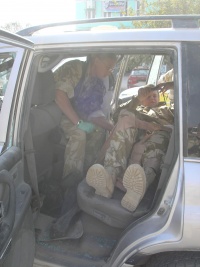
The first vehicle (four packages; three British soldiers and the local Afghan interpreter) had driven through the ambush and, bearing in mind the critical nature of the injuries in this first vehicle, gone straight to the medical facilities at the FSB. The second vehicle had contained three packages and was stuck in action because of a total electric failure of the car, but the soldiers were able to return fire and gain fire superiority. One, the MOT medic, was laid across the rear seat of the shot-out vehicle.
There was an obvious wound from ballistic trauma to the left thigh, with entry and exit wounds and he was a clear P1 casualty. External bleeding was light and appeared mainly venous. His wound was dressed properly and morphine 10 mg administered. He was then slid on to a stretcher and moved to the ambulance where a two neoprene/velcro neighbour splints were applied, making use of the uninjured limb.
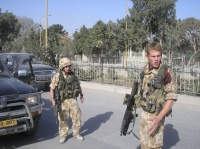
The remaining two soldiers had sustained light superficial flesh wounds (probably fragments), had been able to exit the second vehicle and were labelled P3 casualties.
One of them had clearly grabbed the bull by the horns, and assumed confident control of the immediate area around the ambushed vehicle, busily setting up communications and securing the perimeter. Both were adamant that they were fit enough, and needed, to bolster the guard securing the scene. Cursory inspection showed that both soldiers could safely be transferred by 4 x 4 when relieved, though Archer had been very lucky to avoid chest trauma as his magazine had deflected a bullet and left a red indurated mark on his upper sternum/chest. The BFA departed the scene at around 1010, heading for the FSB.
2. LtCol Ritter:
Around 09:35 a British captain came to the German camp which was close to the British FSB and asked me to assist with the treatment of an unknown number of casualties with gun-shoot – wounds. After alarming my ambulance – team, we left to the Role 1 facility at the FSB. Also I gave the order, to send the remaining German medical personal there too and to inform the Dutch medical crew.
Treatment of the first two patients:
After arriving at the FSB Role 1 I was confronted with the following scene:
2 patients were lying on a stretcher. The Swedish MO and the two Swedish nurses were busy with the first treatment of the two casualties.
Patient 1:
He had obviously a cardiac arrest and was undergoing CPR by his comrade who drove him there and a Swedish nurse. He wasn´t yet intubated or had an iv-line. A small entrance shoot – wound at his left chest between the 6th and 8th rib and an anaemic skin colour were visible.
Patient 2:
He was conscious, shivering and had a shoot wound in his left upper abdomen in hight of the spleen and a touching shot at his left elbow. The Swedish MO and a nurse just tried to establish an iv-line.
An unknown number of further casualties was said to arrive soon.
I decided to treat patient one first, because the Swedish MO took care about patient 2.
Following ATLS procedures, I made an initial assessment followed by a primary survey but didn´t found an exit wound. I established an IV-line and intubated the patient 1. Rapidly the endotracheal tube was filled with blood and after 10 minutes of CPR and another patient in a critical status waiting for further treatment, I decided to stop the CPR and declared the death of this patient.
He was at least for 20 minutes undergoing CPR, which had began during the way to the FSB under poor circumstances. In general, the chance of surviving a cardiac arrest after a high velocity shot wound is poor, especially when there is no reversible cause like a tension pneumothorax.
Patient number 2 was in a critical condition. The primary survey showed no A-problem, no B-problem but increased breath rate, a C-problem with weak and rapid radial puls, palely skin, no D-problem. There was only an entrance wound as described before, no exit wound. We checked the back without any pathological signs or exit wounds. He was still conscious but had pain and fear for his life. I asked my team to prepare everything for a rapid-sequence-induction (rsi) and a second IV line.
I decided to inform the Dutch CH 47 to get prepared for a rapid medevac to Kunduz. I also called the CSU in Termez, to alarm the German medevac CH-53 GS, because I knew, that it would take 30 minutes to get in the air and another 20 minutes to arrive in MeS. I also asked the CSU to inform RCC Kabul, to call me back, because I had difficulties to reach them.
Meanwhile my team had established a second IV-line and was prepared for the RSI.
After intubation and reevaluation he was stabile and well ventilated with no A/B/C problem. We also put him into anti-shock-trouwsers, which was not insufflated yet to have an additional therapy option in case of a hypovolemic shock during the flight t
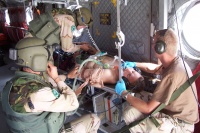
o Kunduz.
He was transferred with the German ambulance to the Dutch CH 47. I called the PRT Role 2 in Kunduz to inform them about the arrival of patient 1 in at least 1 hour and an unknown number of further casualties. I also said that I would inform them directly, when I would have new information and asked them how many patients there able to take.
Meanwhile additional Dutch medical personal arrived on scene. All together we were 1 SWE MO, 1 anaesthesiologist NL, 1 surgeon NL, 1 general practicer NL, 4 nurses (SWE, NL, GB; GE) and 4 paramedics GE and myself.
RCC Kabul meanwhile called back, and I gave them a detailed report and asked them, to get the C 160 medevac in Termez ready for action, because I knew, that it would take about 3 – 4 hours. I wanted to have the opportunity, to medevac the patients also to Kabul via Kunduz the same day.
After all patients were brought out, I was asked to be the MIO. I agreed and made two teams out of the present personal, to be ready for the next patients. I also gave the order to prepare drugs, infusions etc..
3. LtCol Robertson:
During the journey to the FSB MO PRT initiated an IV infusion and commenced inhaled Entonox as an adjunctive analgesic to help cope with the bumpy unsealed areas of road.On final approach to the FSB/APOD area at 1030, the location of immediate Role 2 support was uncertain. With the closure of the Dutch Role 2, and the recent arrival of the German MO, it was decided to head for the Jordanian Role 2 (JO Hosp). After some initial difficulties communicating in English by mobile phone with the staff at the JO Hosp, the BFA headed for their front gate. At this moment further instruction was received that the air ambulance was imminent and the BFA was instructed to make for the FSB Swedish Med Centre for further treatment and triage, arriving at around 1035. There the PRT Medical team and the patient were received by Major Ritter, the newly arrived German MO (and a specialist trainee in anaesthesiology and emergency medicine) leading a team of Dutch d
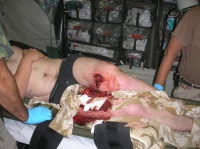
octors plus one Swedish MO.
The wounded team-medic/ patient 3 was stretched off the BFA and the bullet wound to the left thigh was thoroughly inspected.
4. LtCol Ritter
Treatment of the remaining patients:
After the arrival of the GB ambulance with LtCol Robertson and another vehicle with two other casualties I did a short triage and initial assessment.
Patient 3 was hand over to the Dutch team. He had a shot fracture in his left femur, was stabil and conscious and had no A/B/C/D problem. Haemostasis was achieved, pain medication delivered and he was made ready for air ambulance transfer to Kunduz. He had a brave humour and pointed out, that he was afraid not to be able to play soccer next saturday.
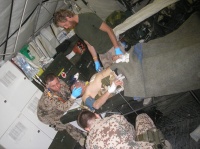
Patient 4 was the most lucky guy of the day! He showed me his magazine where a bullet was stuck inside. He wasn´t wearing a bullet proof west and the magazine prevented him from death! It was placed right before his heart and stopped the bullet. He had a haematoma on his sternum and seemed to have a shoot fracture of his left underarm and had a shock. Because of this, he is still alive! There was no sign for pulmonary or other intrathoracal damage.
Patient 5 had a shoot wound in his left shoulder, was conscious and stabile. His biggest wish was to pee as soon as possible.
In the following time, we stabilised all patients, gave analgetics to patient 3 and 4 and prepared them for the transport with the CH-53 GS medevac. I also informed Kunduz and RCC Kabul about our first diagnoses and plans. From the GB doctor I received the information, that another GB soldier and the AFG translator were brought to the JOR MASH, both lightly wounded.
I decided, that both should be brought to me, that they could be also be medevaced to Kunduz.
When the CH-53 GS arrived, patients 3, 4 and 5 were brought to the CH-53 GS medevac, patient 6 to the CH-53 GS transporter. The AFG translator stayed at the JOR MASH by wish of the GB doctor.
I again informed Kunduz about the correct number of patients and their injuries and flew with the CH-53 GS medevac to Kunduz to be able to report immediately and correct in case of questions concerning the patients.
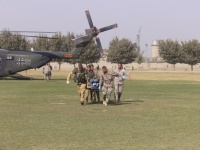
After a stabile transport, we arrived at around 12:00 in Kunduz, where we were picked up by 3 GE ambulances.
After arriving at the German Role 2, I informed the anaesthesiologist about the treatment, the drugs we had given etc.
5. LtCol Robertson
They subsequently transferred to Kabul the following day, 30 Oct, at 0830. The first patient underwent emergency surgery at Kunduz, including removal of his spleen, chest drain for localised lung damage and small pneumothorax and surgical repair to damaged bowel.Unfortunately the splenectomy will demand a permanent medical downgrading to P3 or P7, affecting future deployability. The third patient has lost a significant amount of his femur through ballistic trauma; he faces a long hard road through rehabilitation. The time of this report, the psychological impact of the 29 Oct attack on all five soldiers remains unquantified, with no formal military specialist in post-traumatic mental health disorders yet available to perform an assessment. It would not be unexpected that, for some of the soldiers, the psychological injury may prove to be greater than the physical injury.
The Interpreter.
The interpreter was keen to remain in MeS but really required an ultrasound exam to precisely localise the shrapnel. MO PRT’s own portable scanner was stuck at the PRT, but the JO Hosp kindly allowed him to use their own scanner to identify the shrapnel fragment on the right hand near the 4th C-MCP joint. The JO Hosp surgeon then extracted the fragment.
Summary: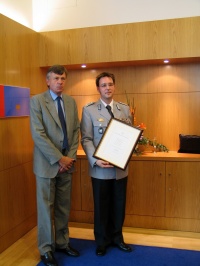
By view, we have to thank everybody who were involved in the treatment for their professionalism and perfect work. Their was no noise, no arguing and everybody did a great job. It was amazing, how easy 4 nations worked together!
As a special sign of appreciation from the British army, LtCol Ritter received the Queen´s Commendation for Valuable Service at the British Embassy in Berlin in 2007.
Date: 10/12/2011
Source: MCIF 4/11











